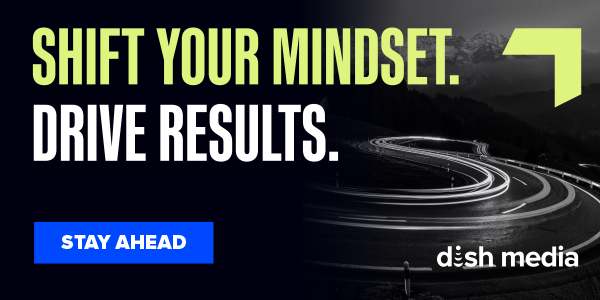Following the broader digital ad world, the TV market is rapidly moving to the impression-based model. Managed services for impression-based (including addressable) remain alive and well, but this year’s Upfronts demonstrated the most dynamic growth centers on the programmatic marketplace.
Growth in programmatic TV is more than a reaction to shifting viewership. It’s the result of the strategic embrace of programmatic by both buy- and sell-side players.
Buy-side players want the flexibility to bid and optimize campaigns in real time, driving better planning, targeting, reach, measurement and attribution. On the sell side, embracing programmatic TV opens up access to the full demand pool of ad and marketer dollars.
Three principles to guide programmatic TV’s evolution
Amid this rapid shift toward programmatic TV, buy- and sell-siders are hungry for best practices to ensure they’re capturing the full potential of the impression-based model. At DISH Media, our experience building SLING TV’s programmatic business showed us what works and what doesn’t – for both the sell side and buy side. These experiences shaped a strong vision of what we collectively should expect from programmatic TV.
Here are three principles that should guide the healthy evolution of programmatic TV:
1) Supply Quality
Put simply, buyers need to know what they’re buying. Understand where your dollars are going and ask the right questions. With growing fragmentation in the ad tech world, buyers want (and deserve) a more complete view of what they’re buying.
They should be able to confidently know they’re buying Tier-1 video content. They should understand what data points they can decision on for targeting, reporting, measurement and attribution. And this needs to extend to things like video completion rate and live content vs. VOD content.
2) Supply Equality
Many advertisers still hesitate around programmatic TV over worries they won’t have access to the same quantity and types of inventory (and thus the same dollars/yield/return down the line) as they can get with IOs.
Programmatic guaranteed deals are so popular right now because it’s the safe programmatic bet. Programmatic guaranteed automates the IO process, but execution remains a managed service and dollar commitments are locked.
Sell siders have their own apprehensions – hesitant to put a significant portion of inventory into the programmatic pool.
If we want to move toward an agnostic ecosystem where advertisers have freedom to take the best route to optimal results, media companies need to prioritize supply equality: The inventory available for programmatic should be equal to that for IO/guaranteed deals.
We’re making progress, but big disparities remain between IO and programmatic supply.
Advertisers need to be diligent about understanding a potential supply-side partner’s ratio of what they can buy on an IO basis compared to in a biddable environment. And they should be adamant in calling out and pushing to minimize those gaps.
But if we want advertisers to develop a bigger appetite for biddable advertising, media companies also need to take a leap toward supply equality.
For example, DISH Media’s latest innovation DISH Connected™, has made its DISH set-top box inventory available for purchase programmatically. For the first time ever, we have now achieved true supply equality by shifting to a new model that makes linear TV inventory available in a true programmatic, real-time biddable environment.
3) Data Availability and Transparency
For advertisers to achieve the benefits of programmatic TV – better targeting, measurement, attribution, etc. – they need high-quality data they can action in real time. That means taking a hard look at what data a sell-side partner can provide, including what percent is first party, what percent is authenticated and what percent is owned.
Tools now exist to help advertisers and agency partners get objective answers to these questions. All buy-side stakeholders should be leveraging these tools to understand the quality and accuracy of record-level data, as this data quality directly fuels the quality of campaign results.
On the sell side, building out highly accessible, high-quality pools of first-party data will provide critical differentiation in a crowded field. But while ownership of identity data will matter more than ever against the backdrop of cookie deprecation, sell siders need to recognize that participating in an omni ecosystem is beneficial for all media companies.
Not too long ago, linear TV was still the focus of Upfronts – the main vehicle for reaching people up and down the funnel. Today, it’s clear that impression-based advertising will be the dominant model in the future of TV. We’re already seeing the start of this surge: eMarketer expects U.S. spending on linear-addressable to reach $4.2 billion in 2024 – doubling where that figure sat in 2020.
It’s exciting to think of how the impression-based TV landscape will evolve over the next several years. Growing fragmentation will give TV providers the opportunity to create new, more flexible solutions – and capture more of the demand pool of ad and marketer dollars. These flexible programmatic offerings from the sell side will enable advertisers to execute precise targeting, accurate measurement and attribution, ultimately driving smarter spend and generating greater ROI for their businesses.
For more articles featuring Kevin Arrix, click here.














